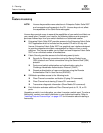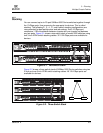
3 – Planning
Device Access
3-2 59096-04 A
S
3.2
Device Access
Consider device access needs within the fabric. Access is controlled by the use of
zoning. Some zoning strategies include the following:
Separate devices by operating system.
Separate devices that have no need to communicate with other devices in
the fabric or have classified data.
Separate devices into department, administrative, or other functional group.
Reserve a path and its bandwidth from one port to another.
Zoning divides the fabric for purposes of controlling discovery and inbound traffic.
A zone is a named group of ports or devices. Members of the same zone can
communicate with each other and transmit outside the zone, but cannot receive
inbound traffic from outside the zone. A port/device can be a member of up to
eight zones whose combined membership does not exceed 64.
Zoning is hardware enforced on a switch port if the sum of the logged-in devices
plus the devices zoned with devices on that port is 64 or less. If a port exceeds
this sum, that port behaves as a soft zone member. The port continues to behave
as a soft zone member until the sum of logged-in and zoned devices falls back to
64, and the port is reset.
A zone can be a component of more than one zone set. Several zone sets can be
defined for a fabric, but only one zone set can be active at one time. The active
zone set determines the current fabric zoning.


















